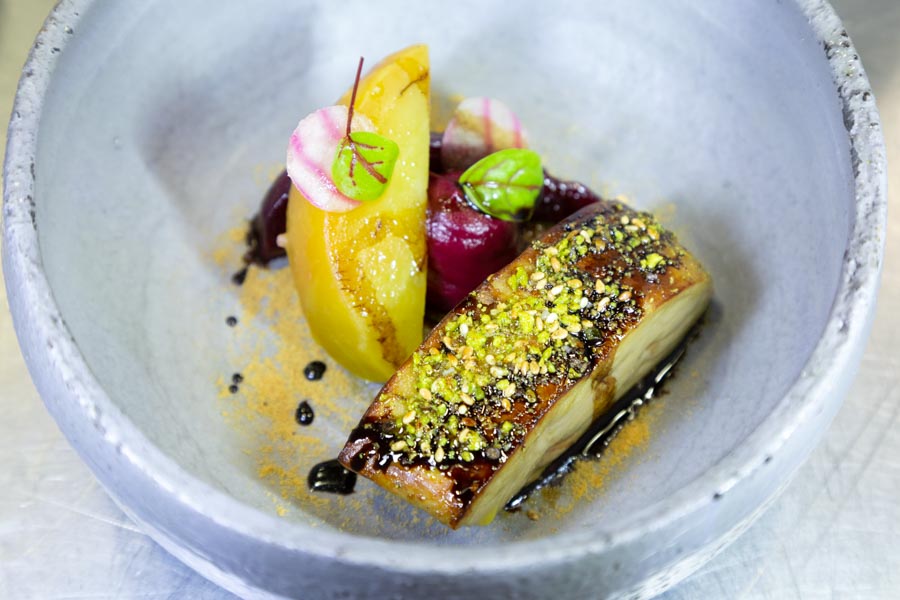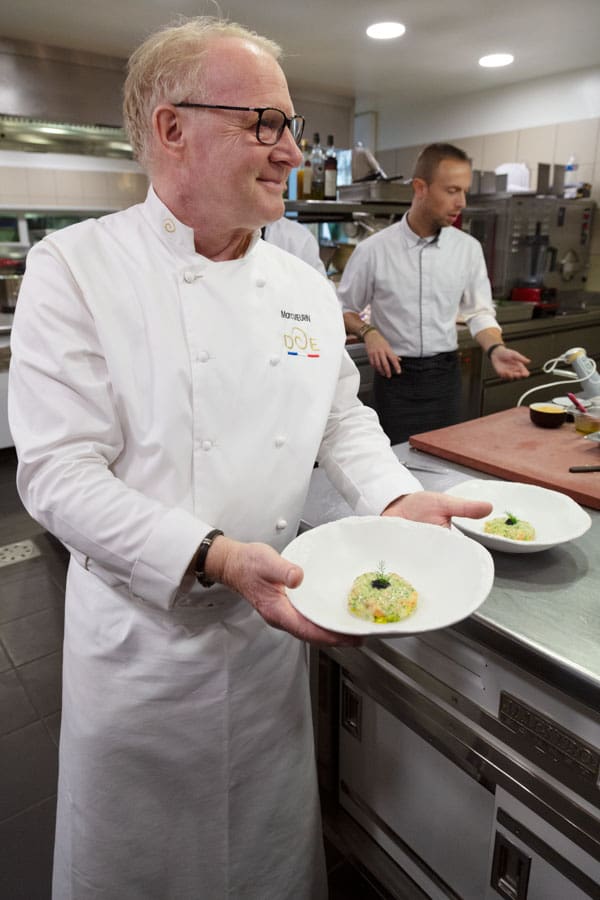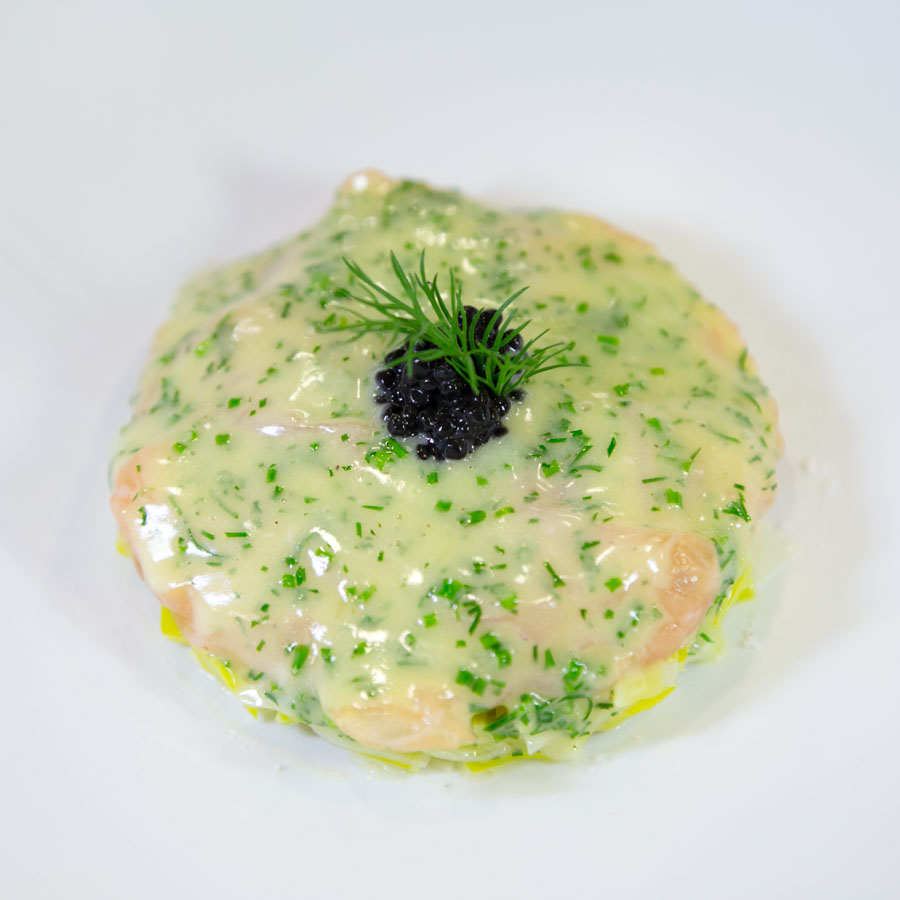Stuart Forster experiences a cookery lesson with chef Marc Meurin in the kitchen Le Meurin, his restaurant with two Michelin stars at Busnes in northern France.
Disclosure: Stuart Forster, the author of this post, travelled to France and participated in the cookery class as a guest of Pas de Calais Tourisme and retained full editorial control of this post. Neither Pas de Calais Tourisme nor Le Meurin reviewed or approved this article. Some of the links below and banners are affiliate links, meaning, at no additional cost to you, I will earn a commission if you click through and make a purchase.
Since this post was published, the Château de Beaulieu has come under new management.
Cookery lesson with chef Marc Meurin
Chef Marc Meurin holds two Michelin stars for his restaurant Le Meurin at the Château de Beaulieu in Busnes, France. Today I’m one of half a dozen people, all from the United Kingdom, that he greets and welcomes into his kitchen to participate in a cookery class.
We weave between Le Meurin’s stainless steel work surfaces and then gather around a cooking station.
Mathieu Boutroy, one of the restaurant’s executive chefs, introduces himself and Sebastian, who’ll be assisting. Mathieu will be doing most of the talking today, otherwise everything will have to run through a translator. Unfortunately, my understanding of the French language is too limited to participate in a cookery class without translation.
He explains that we’ll be learning how to cook three of the dishes that are associated with Le Meurin: carpaccio of scallop, white leeks with smoked salmon plus poached foie gras with beetroot cream.

Preparing carpaccio of scallop
The scallops served at Le Meurin are sourced locally, from northern France. We hear that for every kilo purchased the restaurant receives approximately five scallops.
The restaurant sources its principal ingredients from local producers who are specialists in their field. “The prices for mushrooms, truffles and scallops are expensive but the quality is very high. A regular customer can’t understand why we buy asparagus for around 40 euros a kilogram. Only the two Michelin-starred or three Michelin-starred chef buys this type of produce,” explains Mathieu.
We hear that the local scallop season starts at the beginning of October and continues until the end of April or the beginning of May, depending on the weather. “You cannot eat scallops in summer — only frozen ones. If you see them on the menu of a restaurant in August you have to change! Choose another restaurant,” jokes Mathieu as he opens a scallop and holds it up for the group to see.
“When you buy scallops you need to buy live scallops,” he encourages and points to the raggy bits that surround the white meaty flesh. “We call this la barbe, meaning ‘the beard’. From this you can cook a very good sauce,” he explains.
Lessons About French cuisine
“The speciality of French cuisine is that each time we cook produce we make a sauce or jus from some part of it. From scallops, we make a sauce from la barbe. If I was cooking fish, I would use the bones to make a stock for a sauce,” says Mathieu while Monsieur Meurin looks on at his work.
We observe how to open a shell and follow the scallop’s shape with a knife. Mathieu then demonstrates how to cleanly scoop the white meat of the scallop from the shell using just a spoon. He separates and discards the yellow part — the coral — which he says never eats and recoils in mock horror when one of the group says that he uses it regularly.
We learn how it’s important to wash scallops twice. The first time they should be washed then placed on a towel and left for five minutes. The second time they are rinsed under running water, in case there’s any sand left on them.
“A good scallop is a scallop without sand,” explains the chef. “We bought this week maybe 300 kilograms of scallops and had about five kilograms of sand.”
Cookery tips for preparing scallops
He sorts the scallops by size and rolls them in aluminium foil, twisting the ends until the contents are squeezed tight, creating an air-tight holder. According to Mathieu: “Like this, you can keep them in the fridge for four days safely. You can put them in the freezer if you want. If you put them in the freezer they remain fresh. The main mistake of hobby cooks is to put old produce in the freezer — it’s not a magic tool!”
Carpaccio of scallop has been a seasonal feature on Le Meurin’s menu since the late-1990s.
We then receive a pro tip for slicing scallops. Placing them in a freezer for 15 to 20 minutes, in order to cool, makes them easier to cut. It helps push the individual scallops together so that pieces two to three millimetres thick can be sliced. Simple but highly effective.

A delicious sauce for scallops
The sauce for the carpaccio of scallop starts with a spoonful of honey and lime juice. Salt and pepper are added early so that they dissolve in the acidity, something that Mathieu emphasises before whisking the mixture in a stainless steel bowl. Then comes calamansi vinegar, from the Philippines — which is citrusy, like a cross between sweet lime and orange — followed by white balsamic vinegar. A gentle black olive oil — significantly lighter than regular olive oil — is then whisked into the mixture.
Roasted sesame seeds, Szechuan pepper and ground coriander are added to the sauce before it’s poured over the thinly sliced scallops. Caviar lime — an ingredient from Australia that’s sometimes known as finger lime and reveals translucent green pearls when sliced — adds a crunchy texture and another level of flavour to the dish.
The slices of scallop marinade for just two or three minutes before they are ready to serve. The result is a delicious starter that elicits wows of appreciation from those of us participating in the cooking class. It’s a dish that I like the idea of preparing at home.
Cooking white leeks with smoked salmon
Mathieu and Sebastian then start to show us how to prepare white leeks with smoked salmon.
“It’s another famous recipe of Monsieur Meurin. It can be prepared in just 10 minutes. It’s something really tasty that you can prepare if someone unexpected comes to your house,” says Mathieu.
He starts by melting butter in a pan, for braising the chopped leek. He freshly squeezed orange juice and salt and white pepper. I’m impressed by his deft wrist flicks to flip the ingredients of the pan. He then mixes in the soured cream and thin slices of smoked salmon.
I notice that none of the recipes we’re learning follow lists of weights or volumes of ingredients. It’s much more about tasting while cooking and adding an appropriate amount according to intuition and taste.

Marc Meurin Michelin-starred Chef
As the demonstration continues and the foie gras is being prepared, I turn to Monsieur Meurin. Via a translator, I hear how he enjoys trying food while travelling.
He explains that many people visit Le Meurin for real, classical cuisine though the amount of sugar in the desserts is being reduced. So too is the amount of fat in the dishes.
I learn that the process of experimenting with new products is collaborative. It involves several of Le Meurin’s staff and Monsieur Meurin’s wife, who he says has a good palate and tastes the dishes. Ultimately all new dishes being added to the menu involve a team of people sitting together to reach a decision.
He tells us how he is the eldest of a family of four children from Lens. After returning home from school on an evening he saw his mother cooking and helped out. That was how he began cooking. Aged around 14, he passed an exam to go to catering school. His parents had two gardens and practically everything they cooked came from them.
I ask if he could cook for anyone who would it be, I ask. He answers that he loves cooking for people who have not previously tested gastronomic cooking. Rather than VIPs, he’d rather cook for his neighbour.
As the cookery class comes to a close Monsieur Meurin beams us a smile and says “it will be a pleasure for me to cook for you tonight.” I look forward to the experience of dining at Le Meurin.
Travel to le Château de Beaulieu
Busnes is 74 kilometres southeast of Calais, a drive of approximately 50 minutes from the French port.
Le Shuttle and DFDS Ferries are options for crossing the English Channel.
Rail travel is an option between stations in the United Kingdom and Béthune.
The map below shows the location of le Château de Beaulieu in Busnes, north-west of Béthune:
Further information
Find out more about things to see and do in the region around Busnes on the Pas de Calais Tourisme website. The France website also has information about the region.
The photographs illustrating this post are by Why Eye Photography, based in the northeast of England. Call 07947 587136 to discuss your photography requirements and make a booking.
If you liked this post why not sign up for the free Go Eat Do newsletter? It’s a hassle-free way of getting links to posts. If you’d like to sponsor a post on Go Eat Do then please feel free to get in touch.
‘Like’ the Go Eat Do Facebook page to see more photos and content.




